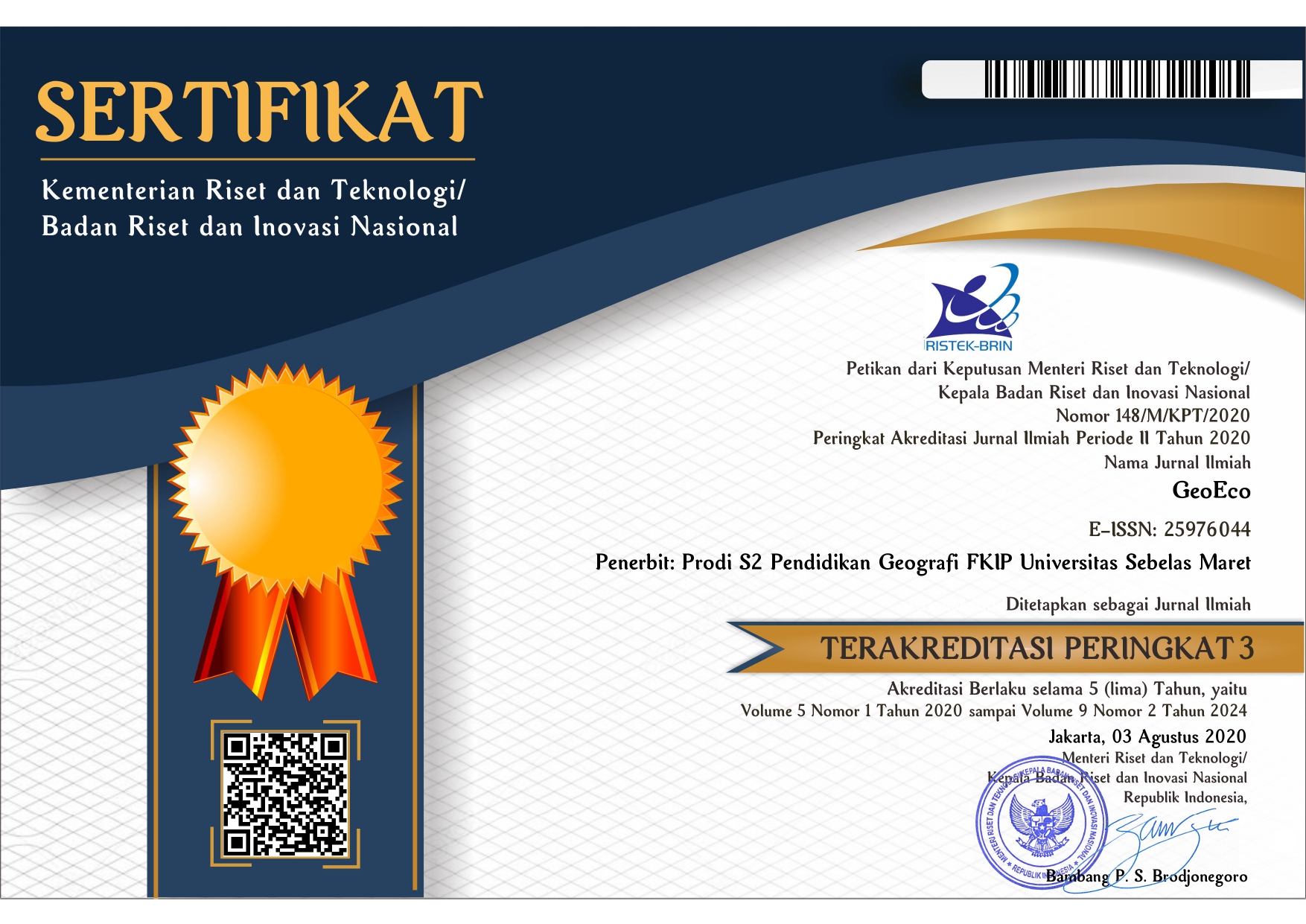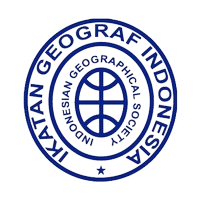DETERMINING TRANS JOGJA BUS STOP LOCATIONS USING A COMBINATION OF SPATIAL ANALYSIS AND FUZZY LOGIC
Abstract
The increase in population from migration coupled with natural growth resulted in a high population density in Yogyakarta City, with a negative impact of traffic congestion due to the number of vehicles that were not proportional to road capacity. One of the efforts to lessen congestion was through efficient public transportation. Trans Jogja can be one of the solutions to this problem. However, despite having up to 90 stops in Yogyakarta City, the existing stop locations are not evenly distributed. Thus, in order to propose appropriate bus stop locations, this study aimed to utilize the weighting and utilization of GIS, based on a number of factors usithe ng fuzzy logic method. The result showed that the weight of eh parameter also influenced locations with a high suitability. Values with a high match were pixel values ranging from 6.824 to 9.49. The location of high suitability was close to the road around the location with a high level of crowds, such as office areas, shopping centers, hotels, educational facilities, and tourism. This study proved that fuzzy logic could be used as a tool in spatial analysis to obtain criteria for a location by considering the probability of correctness of each selected parameter.
Keywords
Full Text:
PDFReferences
Astuti, S. P., Alhakim, T. I., & Setiawan, E. (2021). Evaluasi Transportasi Publik di Surakarta melalui Fuzzy Quality Function Deployment. Jurnal Penelitian Transportasi Darat, 23(2), 122-134.
Corazza, M. V., & Favaretto, N. (2019). A methodology to evaluate accessibility to bus stops as a contribution to improve sustainability in urban mobility. Sustainability (Switzerland), 11(3). https://doi.org/10.3390/
su11030803
Demi, D., Ernawati, E., & Andreswari, D. (2013). Penentuan Lokasi Halte Bus Sekolah di Kota Bengkulu Menggunakan Metode Fuzzy Multy Criteria Decission Making (FMCDM). Rekursif: Jurnal Informatika, 1(3).
Director General of Land Transportation. 1996. Technical Guidelines For Public Vehicle Stopping Number271/HK 105/DRJD/96. Jakarta
Fuzzy. 2019. Retrived from http://elearning.algonquincollege.com/coursemat/viljoed/gis8746/concepts/idrisi/commands/fuzzy/fuzzy.htm
Gartner, G., Meng, L., & Peterson, M. P. (2008). Lecture Notes in Geoinformation and Cartography: Geospatial Vision New Dimensions in Cartography.
Huang, Z. (2014). A hierarchical process for optimising bus stop distribution. Urban, Planning and Transport Research, 2(1), 162–172. https://doi.org/10.1080/
21650020.2014.908738
Pourghasemi, H. R., Pradhan, B., & Gokceoglu, C. (2012). Application of fuzzy logic and analytical hierarchy process (AHP) to landslide susceptibility mapping at Haraz watershed, Iran. Natural Hazards, 63(2), 965–996. https://doi.org/10.1007/
s11069-012-0217-2
Raharjo, R. (2018). Ini Daftar 10 Kota Paling Macet, Yogyakarta di Posisi Ini, TribunJogja.com. Retrieved from http://jogja.tribunnews.com/2018/02/25/inidaftar-10-kota-paling-macet-yogyakarta-di-posisi-ini
Ramadhiani, A. (2018). Ini 10 Kota Termacet di Indonesia, Kompas.com. Retrieved from https://properti.kompas.com/read/2018/02/25/182046621/ini-10-kotatermacet-di-indonesia
SAGA-GIS Module Library Documentation (v2.2.0). 2022. Module Fuzzify. Retrieved from https://saga-gis.sourceforge.io/
saga_tool_doc/2.2.0/grid_calculus_11.html
Saghapour, T., Moridpour, S., & Thompson, R. G. (2016). Public transport accessibility in metropolitan areas: A new approach incorporating population density. Journal of Transport Geography, 54, 273–285. https://doi.org/10.1016/
j.jtrangeo.2016.06.019
Shatnawi, N., Al-Omari, A. A., & Al-Qudah, H. (2020). Optimization of Bus Stops Locations Using GIS Techniques and Artificial Intelligence. Procedia Manufacturing, 44, 52–59. https://doi.org/10.1016/j.promfg.2020.02.204
Susanto, A., Siahaan, Z. B., Setiadji, B. H., & Supriyono. (2014). Analisis Kinerja Lalu Lintas.
Chen, Y., Liu, J., Du, F., Lin, Y., & Zhu, T. (2014). An expert knowledge-based approach to landslide susceptibility mapping using GIS and fuzzy logic. Geomorphology, 214, 128–138. https://doi.org/10.1016/j.geomorph.2014.02.003
Refbacks
- —
- —
- Determining Trans Jogja Bus Stop Locations Using A Combination of Spatial Analysis And Fuzzy Logic
- —
- —
- —
- Determining Trans Jogja Bus Stop Locations Using A Combination of Spatial Analysis And Fuzzy Logic
- Determining Trans Jogja Bus Stop Locations Using A Combination of Spatial Analysis And Fuzzy Logic
- —
- Determining Trans Jogja Bus Stop Locations Using A Combination Of Spatial Analysis And Fuzzy Logic
- Determining Trans Jogja Bus Stop Locations Using A Combination of Spatial Analysis And Fuzzy Logic
- Determining Trans Jogja Bus Stop Locations Using A Combination Of Spatial Analysis And Fuzzy Logic
- Determining Trans Jogja Bus Stop Locations Using A Combination Of Spatial Analysis And Fuzzy Logic
- Determining Trans Jogja Bus Stop Locations Using A Combination of Spatial Analysis And Fuzzy Logic
- —












.png)

